Thursday, April 30, 2020
Wednesday, April 29, 2020
Project #22 - Cardboard Places
Thank you Ms Bri (our Fratney student art teacher), for your second Wednesday project post! I think it is a super thoughtful idea to make art that imagines our inside and outside spaces during this time in which we are all practicing social distancing.
Materials - Cardboard (delivery box, tissue box, shoe box, or pieces of cardboard), paint/paper, scissors, glue/tape, markers/crayons/pens/pencils. Other materials you may want to add.
Making -
1. Find a box. You can cut away part of it if you want to show the inside.
2. Pick a place you want to show. Maybe where you live, a specific room, somewhere you like to spend time, or some place you like to go in your community.
3. Paint the box or glue on construction paper for a base.
4. Use paint, paper, markers, and other pieces of cardboard to create the inside and outside of your place. Think about details of the place you choose.
Make some details out of cardboard and paper for your place.
4. Glue or tape on details on the inside and outside of the place. Add more details with markers if you want!
NOTE - If you do not have a box, use a flat piece of paper to make a relief (when pieces of a sculpture are attached to a background. See below for examples!)
Inspiration -
Ana Serrano is a first-generation Mexican American artist who is inspired by her dual cultural identities. In much of her work, she uses bright colors of cardboard and paper to create buildings inspired by Latino neighborhoods across the US and in her hometown of Los Angeles. She looks at details of places and how people decorate their homes and businesses. Take a look at some examples of her work, and check out her website for even more examples!
Tuesday, April 28, 2020
Art Links
Send your favorite online art links to me (Ms. Sue) at pezanosm@milwaukee.k12.wi.us or place in the comments section below, and we can post them here to share with the rest of our La Escuela Fratney friends.
- Lynden Sculpture Garden's Virtual Hub - A new online resource with virtual tours and resources for families and teachers. When you visit the site, you can subscribe to a list to receive notice as new content is added. https://lynden.tours
- Drawing with Rémy is an interactive art source, where kids of all ages can explore their feelings through fun and imagination during the current COVID-19 pandemic and share with one another. http://remycoutarel.com/draw-with-rmy?fbclid=IwAR33CFMPMToVjpGef0bFv_dmdTX_cEY4x10vp6l9P6I5CFtPFnBNDq8xYUY
- LUNCH DOODLES with Mo Willems! - Thanks to Penny in Ms Lara's K-5 class for sharing. https://www.youtube.com/watch?v=RmzjCPQv3y8&list=PL14hRqd0PELGbKihHuTqx_pbvCLqGbOkF&index=6&t=0s
- 344 Daily Monster - Illustrator Stefan G. Bucher draws a new monster everyday beginning with an abstract ink splash. https://www.youtube.com/watch?v=IyxZikTl240
- Color Our Collections - Makes available dozens of coloring books and sheets based on the archives of many different types of libraries from all over the world. http://library.nyam.org/colorourcollections/
- The Art Assignment - A beautifully designed site that introduces contemporary artists and presents related art assignments, for participants of all ages. http://www.theartassignment.com/assignments-landing
- Art with Mrs. Moe-Rossetto! Art with Mrs M! - Mrs M is an MPS art teacher colleague at Carver Academy. https://www.youtube.com/channel/UCjIayxlej4gr_qg6Ivi5i8g
Monday, April 27, 2020
Project #21 - Still Life in 4 Styles
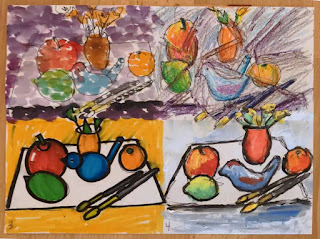
Materials - Still life objects, paper, pen or pencil, any variety of materials that you have available to add color, such as markers, crayons, oil pastels, chalk, watercolor, acrylic paints, etc.
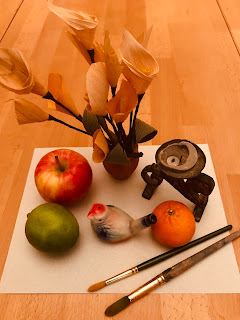
Making -
1. Set up a still life on your table.
2. Fold your paper in 1/2 in both directions to create 4 separate boxes on your paper.
3. Number the boxes. Assign a separate style for each one.
4. Make a sketch in each box, using a different style for each.
- For me, box #1 is "impressionism", a loose style made with dabs of blended colors. Line is not important, so the sketch in this box is simple and light.
- Box #2 is "cubism", a style characterized by a space that is fragmented, so I started by drawing lines that make the space look like a broken window. Then I sketched the still life. Every time i drew up to a line, I continued drawing, but picked a different spot to continue, so that each object appears broken or fragmented.
- Box #3 is "pop art", a cartoon like style where lines shapes and colors are very bold and simplified.
- Box #4 is "fauvism", a more colorful and rough style that often has bold dark outlines.
You can try these same styles, make up your own, or research to find other styles to try.
Impressionist Style - Henri Matisse, "Still Life with Pitcher" Cubist Style - Georges Braque
 |
| Fauvist Style - Gabriele Munter |
 |
| Pop Art Style - Roy Lichtenstein |
Saturday, April 25, 2020
Project #20 - Photo Collage
Materials - Old magazines, scissors, glue
Making -
1. Look through the pages of several old magazines looking for images that you like. Think about finding an interesting setting/background, characters, and details that will add to the story.
2. Cut or tear out the pages containing the images that you like.
3. Carefully cut along the edges of each of your shapes. Don't rush the cutting, because carefully cut images will make an okay collage into a great one.
4. Take some time to play with composing the space, arranging objects and characters until your collage feels the most exciting and interesting to you.
5. Glue your collage pieces together.
Inspiration - Romare Bearden is an important American artist for many reasons, including his use of collage to depict aspects of black culture. Romare grew up in Harlem during the Harlem Renaissance and his art is often compared to jazz music. His artwork communicates powerful themes of social justice and community.
 |
| Romare Bearden, The Train |
Thursday, April 23, 2020
Project #19 - Macrame & Friendship Bracelets
When making friendship bracelets, we are using a fiber arts technique known as "macrame". Macrame is an organized system of making knots to create anything from bracelets to scarves, or even creations beyond your wildest imagination, as you'll see from the artist inspiration at the bottom of this post.
Materials - Yarn (or string, embroidery floss, hemp cord), scissors, tape
In recent years, there has been a resurgence of the use of traditional crafts amongst contemporary artists. Ernesto Neto is a Brazilian artist who uses macrame and crochet to creates large scale works of art. Much of his art works are large interactive environments that people can enter into.
Wednesday, April 22, 2020
Project #18 - Sharing Your Essential Knowledge
Happy Earth Day Fratney students & friends!
Bri Sayeg, Fratney student art teacher, is posting her first project to our blog today. "Sharing Your Essential Knowledge", is a fun way to use drawing and writing to teach other people about something you are interested in &/or know a lot about. This approach to making art is the inspiration of Milwaukee-based artist Colin Matthes. You can learn more about Colin at the end of Bri's post. Enjoy!
Hi Fratney students! Click on this link to see "How to keep a plant alive!!!"
Materials - Paper and marker (or paint, pen, pencil, crayon)
Making -
1. Sit in a place where you feel calm and comfortable.
2. Look at some of the examples from the artist, Colin Matthes, to help come up with some ideas of your own “essential knowledge.”
3. Think of something you are good at. If you are stuck, read the list below for some ideas.
4. Draw your knowledge. Include these three elements in your design: title, directions, and images.
5. Add some contrast - light and dark colors/shapes.
6. If you want to do another, pick a new idea!
1. Sit in a place where you feel calm and comfortable.
2. Look at some of the examples from the artist, Colin Matthes, to help come up with some ideas of your own “essential knowledge.”
3. Think of something you are good at. If you are stuck, read the list below for some ideas.
4. Draw your knowledge. Include these three elements in your design: title, directions, and images.
5. Add some contrast - light and dark colors/shapes.
6. If you want to do another, pick a new idea!
Ideas-
- How to make a food (something you like to make!)
- How to play a game
- How to do a dance
- How to draw/paint something
- How to do a sport
- How to decorate/celebrate for a holiday
- How to go camping/do something outside
- How to do something with someone
- How to be great at…
- How to do a daily task
Inspiration
Colin Matthes is an artist from Milwaukee. He works on collaborative projects with Justseeds Artists’ Cooperative and does individual projects as well. For one of his projects, Essential Knowledge, he creates drawings teaching skills for success in challenging situations and tells stories. Here are some examples of his work. As you look over them, think, what is something that you know how to do well?
Total Essential Knowledge is another project that is ongoing that he works on. He facilitates events that allow participants to find something unique they do, know or think and create an instructional drawing to share their information. He was an artist in residence at La Escuela Fratney in 2018. During his time at Fratney, he had students share their curiosity, experiences, and interests through narratives using drawing and text in dip pens, brushes, and ink. Check out this link for some examples of the project:
Images from Colin Matthes’ Essential Knowledge:
Tuesday, April 21, 2020
Tomorrow, April 22, is EARTH DAY!
Tomorrow is the 50th anniversary of Earth Day. Wow. As the whole world is impacted by the Covid-19 pandemic, we are pulling together, sometimes slowing down, and learning new ways to care for each other and the earth. This year, there will be no large public gatherings, so our celebrating will be quieter. Tomorrow is Earth Day. Take a deep breath, close your eyes, smile to yourself, and choose one special thing that you can do to say "thank you" to our Mother Earth. Here are some special "thank you" art works made by students today.
 |
| Clockwise from top left: Cece, Victoria, Sophie and Audrey |
Monday, April 20, 2020
Project #17 - Colors, Shapes and Stories in 3-D
This Wednesday, April 22nd, is Earth Day. Let's celebrate this important day with another project using recycled materials. I should tell you that I got this idea from my nephew, Jackson, who lives in Oakland, California. The artist who inspired this project is Frank Stella. You can read more about him at the end of this post.
Materials - Recycled materials (we used cardboard, but you could also use plastic, foil, styrofoam or other scrap materials), scissors, paint (if you don't have any paint, you could also use markers, crayons, or even scraps of colored paper)
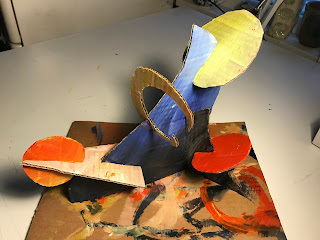
Making -
1. Cut your scrap material into a variety of sizes and shapes that can be both geometric or organic (see vocabulary below).
2. Connect pieces together by cutting notches into each piece and then sliding them together.
3. To make your art a free standing sculpture, you will have to choose two or more pieces that, when put together, will be free standing.
 4. Continue to add other shapes by cutting notches and sliding them together.
4. Continue to add other shapes by cutting notches and sliding them together.
5. When you have finished designing your composition of shapes, you can paint them just as they are, OR, you can slide the pieces apart to paint each one separately.
6. When the paint on both sides of your shapes is dry, you can slide the sculpture back together.
7. I like the look of the scrap of cardboard that I used to paint on, so I am using part of it as a base.
Vocabulary -
3-d (3-dimensional)- an object that is not flat and has more than 2 dimensions in space, so it not only has height and width, but also depth.
Geometric shape- a shape that is uniform according to mathematical descriptions, such as circles, triangles, squares and so on.
Organic shape- is less predictable or uniform, like the shapes of things you find in nature, such as clouds, leaves or puddles of water.
Inspiration - Frank Stella is an American artist best known for his use of shape, color and pattern. His earlier works were traditional rectangular paintings of geometric forms and lines. Over time, he experimented with changing the normal shape of his paintings, instead using organic shapes with more and more texture. Eventually, he broke the painting surface into a combination of separate shapes connected at different angles in space. By doing this, his painting became sculptures. Frank Stella said that he composed shapes and colors to tell an abstract story.
Materials - Recycled materials (we used cardboard, but you could also use plastic, foil, styrofoam or other scrap materials), scissors, paint (if you don't have any paint, you could also use markers, crayons, or even scraps of colored paper)

Making -
1. Cut your scrap material into a variety of sizes and shapes that can be both geometric or organic (see vocabulary below).
2. Connect pieces together by cutting notches into each piece and then sliding them together.
3. To make your art a free standing sculpture, you will have to choose two or more pieces that, when put together, will be free standing.
 4. Continue to add other shapes by cutting notches and sliding them together.
4. Continue to add other shapes by cutting notches and sliding them together.5. When you have finished designing your composition of shapes, you can paint them just as they are, OR, you can slide the pieces apart to paint each one separately.
6. When the paint on both sides of your shapes is dry, you can slide the sculpture back together.
7. I like the look of the scrap of cardboard that I used to paint on, so I am using part of it as a base.
 |
| My nephew Jackson's sculpture |
3-d (3-dimensional)- an object that is not flat and has more than 2 dimensions in space, so it not only has height and width, but also depth.
Geometric shape- a shape that is uniform according to mathematical descriptions, such as circles, triangles, squares and so on.
Organic shape- is less predictable or uniform, like the shapes of things you find in nature, such as clouds, leaves or puddles of water.
Inspiration - Frank Stella is an American artist best known for his use of shape, color and pattern. His earlier works were traditional rectangular paintings of geometric forms and lines. Over time, he experimented with changing the normal shape of his paintings, instead using organic shapes with more and more texture. Eventually, he broke the painting surface into a combination of separate shapes connected at different angles in space. By doing this, his painting became sculptures. Frank Stella said that he composed shapes and colors to tell an abstract story.
 |
| Frank Stella, Exotic Bird Series, 1978-1979 |
Friday, April 17, 2020
Project #16 - Abstract Expressionist Painting
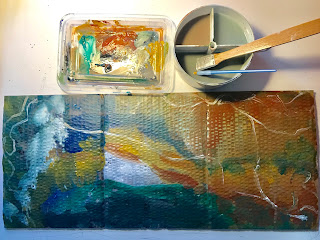 Today I was with some students (virtually) for a Friday "open studio" or hangout time, I noticed one student, in particular, was experimenting with mud painting (Project #11). Her playful approach to painting reminded me of a style of art known as abstract expressionism (see vocabulary below). Later, I was inspired to dive a little deeper into this approach to painting, which for me is about experimentation, play and meditation.
Today I was with some students (virtually) for a Friday "open studio" or hangout time, I noticed one student, in particular, was experimenting with mud painting (Project #11). Her playful approach to painting reminded me of a style of art known as abstract expressionism (see vocabulary below). Later, I was inspired to dive a little deeper into this approach to painting, which for me is about experimentation, play and meditation.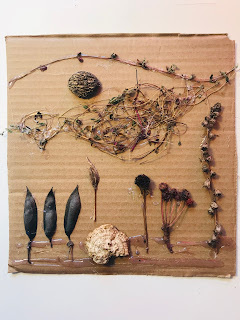

Materials - Cardboard scraps, collage items (collected from nature or recycled materials), glue, paint, paintbrushes, palette for mixing paint (I used a plastic lid), container of water
Making -
1. Glue materials to your cardboard to create texture. It's okay to do this with your own style, which could be more abstract and random or more controlled and patterned. My first attempts were more organized like a landscape. I am slowly learning to work more abstractly.
2. Using any kind of paint that you have, choose three colors that you like, plus black and white. Put some of each color onto your palette.
3. Use your imagination! The trick to beginning is to NOT overthink or expect perfection. The whole idea is to play.
4. Pick a color and a spot on your cardboard and begin. Keep your brush moving and mix your colors as you go.
5. Add water to experiment with the consistency of your paint.
6. If you like something, do more of it. If you don't like something, cover it with a new color.
7. Experiment with how you hold and move your brush, for example, quick dabs or long twisting lines.
8. Stop when you feel the space is layered and filled up enough.
9. Step back and take a look from the other side of the room. That will help you to see your painting with fresher eyes.
10. Maybe a new color of detail will pop into your mind. That's called intuition. Follow it.
Often an artist lets a painting sit for days, looking at it to see if new ideas for how to finish appear. It might feel like a struggle to experiment with painting, but it also should feel purposeful and fun. You won't always be in the mood to experiment like this, but when you are, it can really cheer up your day!
Vocabulary
Abstract expressionism- is a style of art first attributed to American painters in the 1940's and 1950's. Abstract means that the art does not look exactly like something we would see in everyday life. Expressionism describes art that communicates emotion and energy. Working in this style, an artist might feel focused, yet also spontaneous. Looking at abstract expressionist art, you might feel your imagination and emotions activated.
Collage - comes from the French verb, coller, which means to glue or attach different materials together.
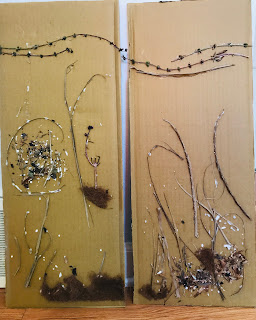
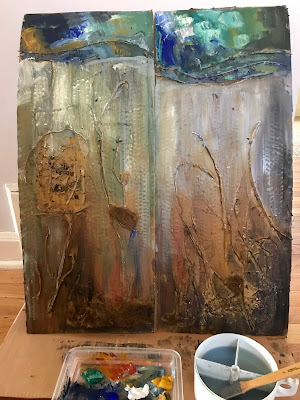
Inspiration - Recently, more attention has been given to women artists who painted in an abstract expressionist style. One of my favorites is Perle Fine. Perle grew up on a dairy farm with six brothers and sisters. She was the only one in her family who became very interested in art while she was still in elementary school. She continued to study art after she graduated from high school. Perle liked to collage different materials into her paintings, and work on different surfaces, like wood and metal. Some have said that her artwork reminds us of our interconnectedness to nature and to each other. I agree!
 |
| Perle Fine, Surfscape #3, 1958 |
 |
| Perle Fine, Summer I, 1985-1989 |
Thursday, April 16, 2020
Project #15 - Los ojos de Dios / Gods Eyes
Materials - Sticks, yarn (optional, plastic yarn), scissors
2. Tie all of the pieces together using slip knots, so that you have one long multi-colored strand of yarn.
3. Choose two sticks that are similar in size and form a cross shape.
4. Tie one end of the yarn into a square knot diagonally around the intersection of the sticks. Then tie another square knot diagonally in the other direction.
5. Begin wrapping. Think of the two sticks as forming four spokes (like the spokes on a bike wheel). Wrap each spoke on time in the same direction, under and around the top, then move to the next spoke and do the exact same wrap, under and around the top.
5. Begin wrapping. Think of the two sticks as forming four spokes (like the spokes on a bike wheel). Wrap each spoke on time in the same direction, under and around the top, then move to the next spoke and do the exact same wrap, under and around the top.
6. Continue in this way, making sure that you are always turning the cross in the same direction, and wrapping the yarn around the spokes in the same direction.
7. Also make sure that each time that you wrap the yarn, you are wrapping it next to the previous wrap, and not on top of it.
8. When you run out of yarn, you can add more, or you can tie a knot around the last spoke to finish.
9. It's a good idea to end with enough yarn to create a loop, so that you can hang up your gods eye.
 |
| God's eye or Ojo de Dios on Quemado Mountain, San Luis Potosi, Mexico |
Inspiration - Los ojos de dios, or gods eyes, originate from pre-columbian cultural and spiritual practices in Mexico. They are hung in homes, work places or placed along paths of travel. Some think they represent the power to see things that are unseen with our eyes, or that they offer protection. The Huichol people of Mexico refer to ojo de dios as a "sikuli". When a father's first child is born, he weaves a "sikuli" with one eye. For each additional child that is born, the father weaves an addditional eye.
Wednesday, April 15, 2020
Introducing Bri Sayeg - Student Art Teacher with Fratney
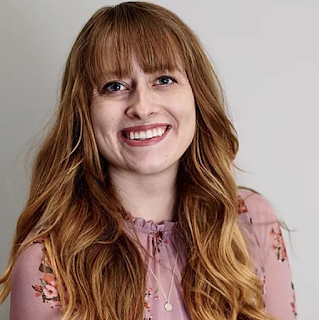 Hello! My name is Ms. Bri, and I am the new student teacher with Ms. Sue. I know that we are all surprised to be in this situation. I would normally be meeting students in the art room at La Escuela Fratney. For now, I will be joining Ms. Sue to communicate with you in the virtual ways that are available to us.
Hello! My name is Ms. Bri, and I am the new student teacher with Ms. Sue. I know that we are all surprised to be in this situation. I would normally be meeting students in the art room at La Escuela Fratney. For now, I will be joining Ms. Sue to communicate with you in the virtual ways that are available to us. I go to school at UW- Milwaukee, and I will be graduating this year to become an art teacher. My favorite kind of art is painting! I like making paintings of people that are important to me. I also love experimenting to make art with materials that I have at home. I am looking forward to meeting as many of you online as possible to make some great art.
(From Ms Sue) Hello Fratney students and families. Let's give a warm welcome to Bri Sayeg, our student art teacher this Spring. I want to share the ways we will continue to stay in touch with you while the schools are closed and teaching and learning have moved online.
- In addition to the projects and other information that you can find here on this blog, Bri will be posting a project every Wednesday. Both of us are trying our best to offer students interesting art activities using materials that you might already have at home. There is a way to leave us comments at the bottom of every post.
- We will also be sharing art ideas to the La Escuela Fratney Facebook group. https://www.facebook.com/groups/142618523850268/
- You will receive an email message from us every Monday. Please feel free to communicate with us at my email, pezanosm@milwaukee.k12.wi.us
- You can also post your artwork (and see the artwork of other Fratney students) on Instagram using the hashtag, #laescuelafratneyart.
- Finally, we are piloting video conference art classes for Fratney students in 2nd through 5th grade. If you are interested, contact me via the email listed above.
Please let us know if you have other ideas for how we can make art or just talk to each other during this unusual time of social distancing.
Tuesday, April 14, 2020
Guest Artists - Victoria, Miriella, Cece & Elliott
Subscribe to:
Comments (Atom)




















